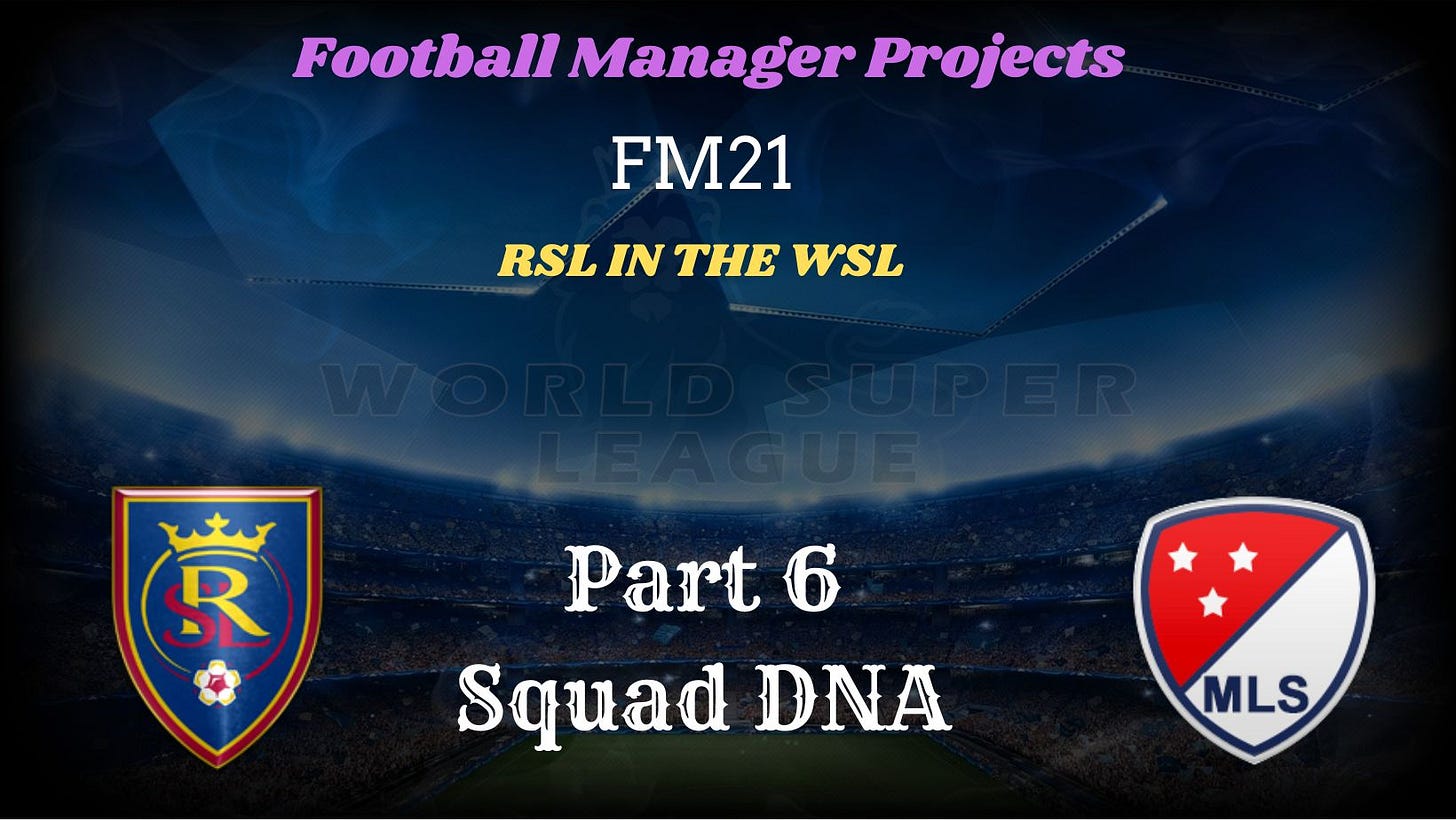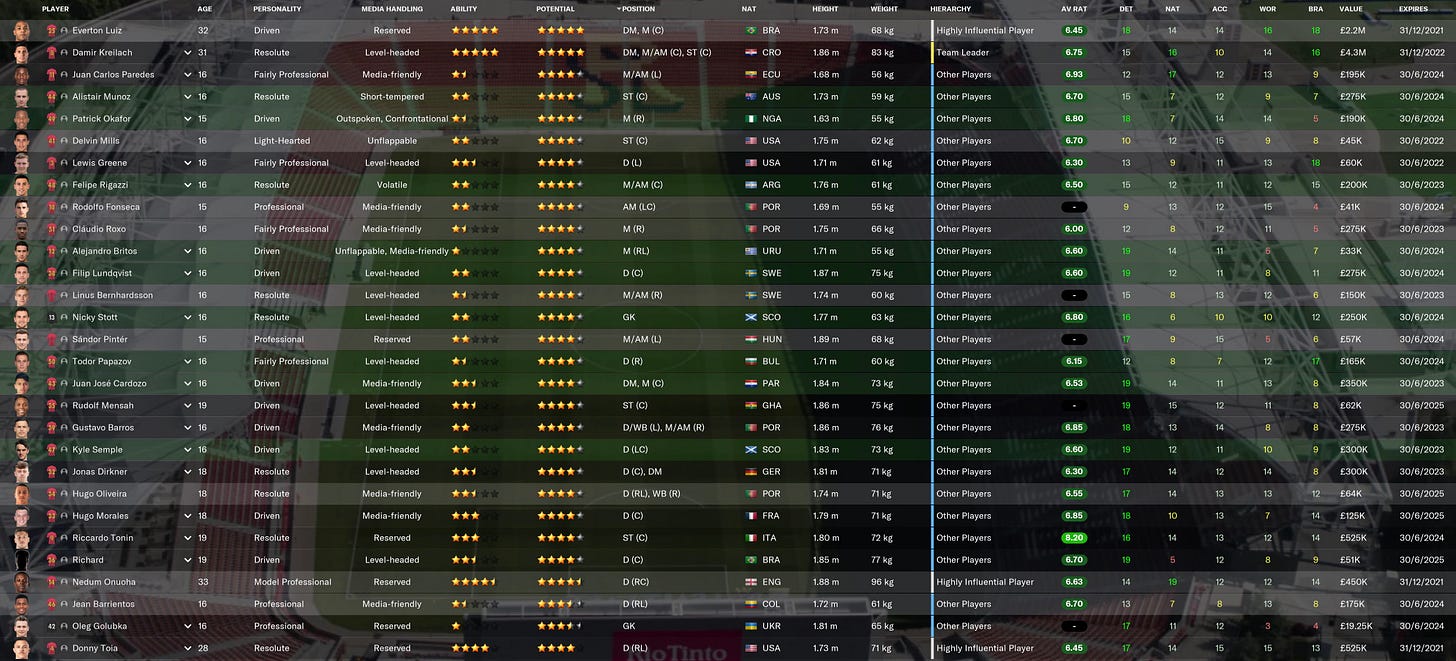Squad DNA
I decided to completely gut the Real Salt Lake squad at the start of this save. I know I’ve mentioned it before, but I thought it would be good to mention again. Today’s squad looks almost nothing like what we had when I came in.
There’s a method to my madness – a system that I’m experimenting with. Actually, one of the goals of this particular project is to see whether this system actually works.
Now, I’m not going to claim that I’m some sort of expert at Football Manager squad building. This is a system I developed mostly on my own, after consulting a variety of sources. Perfect or not, it seems to work.
Let’s get right into it. What is this system, and what is the theory behind it?
Squad Building
One of my favorite FM YouTube videos is this classic, now two years old, from FoxInTheBoxFM:
If you don’t have 20 minutes to watch it, I’ll give you the gist of it.
FoxInTheBoxFM talks about designing a squad around a certain theme or design plan. The idea is to slowly put together a squad made up of players that perform well in certain categories that you have decided to focus on.
As you may or may not know, Football Manager’s game engine is largely driven by player attributes. There are numerous individual attributes, including attributes that are visible and attributes that are hidden. This is the true secret sauce to Football Manager, the thing that determines results more than anything else – more than player values, statistics in prior seasons, height and weight, star ratings, current ability and potential ability ratings, or any other factor.
In this case, FoxInTheBoxFM seems to have chosen arbitrarily which attributes to focus on. He chose determination, teamwork, work rate, composure, concentration, and anticipation. I still don’t quite understand how he came up with these six traits, aside from some sort of innate feeling that determination is probably important, as well as hope that his players would react better to adversity if they had good composure ratings, that they would train better with good work rate ratings, and so on.
Now, you probably won’t be able to build a squad right away that has high ratings in whatever you deem important. FoxInTheBoxFM’s recommendation here is to build up slowly over time – to make player purchases that fit in with your chosen strategy.
This concept – this thematic approach to squad building – is what we call Squad DNA.
Affording Players
Now, we’ve got a problem. We have no money.
I mean, we really have no money at this club. Our initial budget of just over £2 million might let us sign a single established player good enough to play at this level. We simply can’t afford to focus on signing older players.
The idea here is to trade in our older players for young blood. Instead of trying to buy talent, we’re going to have to grow it ourselves.
As a result, I have not purchased any players 20 years old or older. This is what Omega Luke calls the “Youth to Gold” system.
Does it work? We’ll see.
Player Development
Football Manager includes a robust development engine. Through this engine, certain player attributes will change over time. Some players with high potential will see their attribute ratings go up over time – sometimes substantially. Other players tend to flatline early, or even decline when they should be developing.
Not much is known in the community about exactly how this engine works, though, as we will see, there are some people who are actively researching the topic.
What we do know, though, is that some attributes grow (or fall) quickly, whereas others seem to remain static. Thanks to extensive anecdotal evidence, we also know that each individual player has an individual propensity for such rating changes.
The first thing for us to figure out is which ratings tend to change, and which ones tend to stay the same. If we’re going to buy and sell players based on certain ratings, we probably should focus on the ones that are least likely to change.
Which Ratings Change?
In my opinion, Max, also known as Evidence Based Football Manager, is the most important FM YouTuber in the world. His research and experiments are solid, and his conclusions appear to be very trustworthy. I know that others have been working on these problems, but I don’t believe anybody has approached it with the robust and well-defined approach that Max has used.
After running a series of controlled experiments, Max completed a comprehensive list of the way that Football Manager’s in-game training system impacts each visible player attribute. You can watch his conclusion video here:
You’ll probably recognize this video – I’ve linked to it before. For our purposes, though, the most interesting part of this video is Max’s FM training spreadsheet, to which you can find a link in his video description.
Now, you can go up and down this spreadsheet to your heart’s desire. I took some time to do the same before I started up this save. I concluded that the following attributes either do not change as a result of training, or change so slowly that you can’t expect to train improve them through training:
Determination
Natural Fitness
Bravery
Aggression
Determination will be familiar to you if you’re a long-time FM player. We’re going to talk a little bit more about it below. In my opinion, determination is the absolute single most important visible attribute in Football Manager. Of all the visual, searchable attributes in Football Manager, determination is the best predictor of young player development.
Natural Fitness is self-explanatory. It really is “natural.” There’s really nothing you can do in training to change it.
Bravery and Aggression are both kind of odd here. It’s not clear precisely what impact either of these attributes actually has in game. My guess is that you want a high Bravery rating to avoid having an overly timid player. But Aggression? I’m not quite sure what to do with that one.
What do we do with all of this?
We use these attributes when we search for players.
I display each of these attributes on all of the player search and sorting screens in the game – except for aggression, which still strikes me as ambiguous. Take a look at our current roster:
You’ll notice that I also show Acceleration and Work Rate. I look at Acceleration because I want to find players that are quick, and Work Rate because I think it might impact training.
You’ll also notice that we’re not perfect across the board. This is normal. This is because we don’t have a perfect reputation. We’re not to the point yet where we can simply sign any player we want. If we have some success, we’ll get there in the future.
More to come
This is really only half of the puzzle. After our next match, I’ll tell you about how I read player personalities.



